Can You Freeze Cooked Roast Beef? Recipe Ideas Included
You’ve finished your delicious Sunday dinner of roast beef, cooked to perfection in your slow cooker. You don’t want it to go to waste sitting in the refrigerator. And you wonder, “Can I freeze cooked roast beef?” Yes, you can.
It’s the perfect way to preserved perfectly cooked roast beef for use later. Stocking your freezer with cooked meats is a great way to prepare for quick and easy dinners on a busy day. And roast beef freezes well.
Freezing can lock in the flavor and keep your roast beef safe to eat longer. No wasted roast beef this way. But you need to know how to prep and stow it away properly. So it doesn’t get freezer burn.
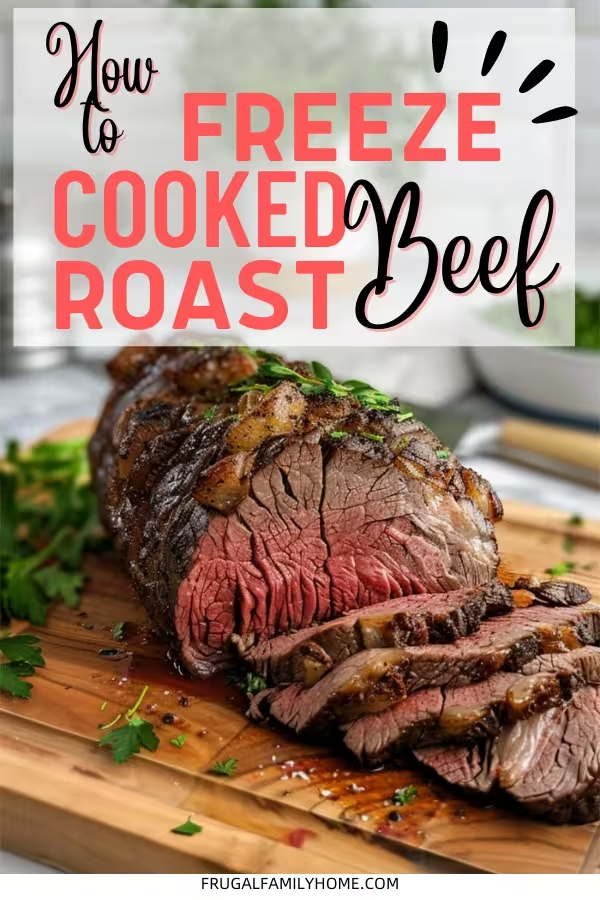
What to Do Before Freezing Your Roast Beef
You have roast beef leftover and with the cost of meat, you don’t want to waste a bit. You know you can freeze fresh beef or raw meat but what about cooked meat. What about meat that was frozen then cooked, can you freeze that again? The answer to both of those questions is yes, but you need to follow a few steps to make sure it’s freezes well by following this freezing process.
Does it Matter How I Cooked the Roast Beef?
It doesn’t matter what cooking process you used. You can cook the roast beef in a pressure cooker, like an instant pot. Or in a slow cooker or the oven it doesn’t matter. You can freeze cooked roast beef for later use.
Cool the Cooked Roast Beef
The first step is to let the roast beef cool. No matter what cooking method you used to cook your roast beef, it’s important to let the meat cool before freezing. This is an important step because hot food in the freezer can increase the temperature affecting other frozen items. Which can affect bacterial growth. So be sure to cool the meat before you freeze it.
Remove any juice from your roast. Save it in a separate container for use later when you reheat. Or you can use it in a gravy recipe or to boost the flavor of store bought broth.
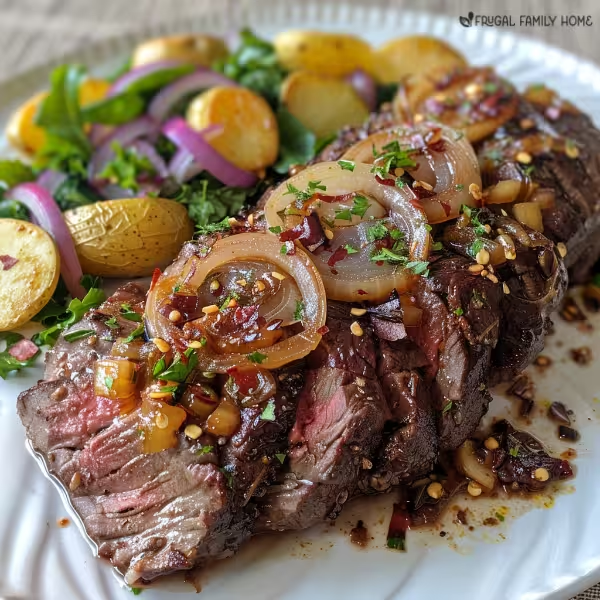
Seal in the Freshness and Protect
Wrap the Roast Beef to Seal in the Freshness
Next you want to wrap the beef tight in plastic wrap or you can use a vacuum sealer to really get the air out. Take your roast beef and wrap it snugly, ensuring there’s no room for air to sneak in. Squeeze out as much air as possible; it’s the secret to keeping your beef tasting like it just left the oven. If you’ll be using a vacuum sealer but sure to get the air out but don’t pull the juices out of the meat. Stop the sealer once the air is removed.
If you aren’t using a vacuum sealer it’s a good idea to double wrap your cooked roast beef. A double wrap won’t hurt. I like to use a layer of plastic wrap first, but you can wrap the roast beef in freezer wrap, freezer paper, or aluminum foil too. Take your roast beef and wrap it snugly, with each layer.
Why Double Wrap the Meat?
Avoid Freezer Burn, It’s the thief of taste and texture. And it’d be a crying shame for your roast beef to fall victim to it. Double wrapping is your beef’s shining armor. The cold can be cruel; don’t let it rob your meat of its delectable juiciness.
Bag and Label
Protect the flavor as best you can by using plastic bags. Use an airtight plastic bag or airtight freezer bag for good measure. Slip that securely wrapped roast beef into the bag. Then, press out as much air as possible before sealing it shut. You might think it’s overkill. But it will help you prevent those dreaded ice crystals from popping up.
Put a label on it with the date. You think you’ll remember when you froze it, but chances are, you won’t. And you don’t wanna take a wild guess weeks or months from now.
That’s it! Follow these steps, and you’ve locked in that rich, mouth-watering flavor for another day. When you’re ready to enjoy your preserved beef, you’ll be glad you took the time to shield it properly. Because who doesn’t look forward to relishing a splendid slice of roast beef that’s just as good as the day it was cooked?
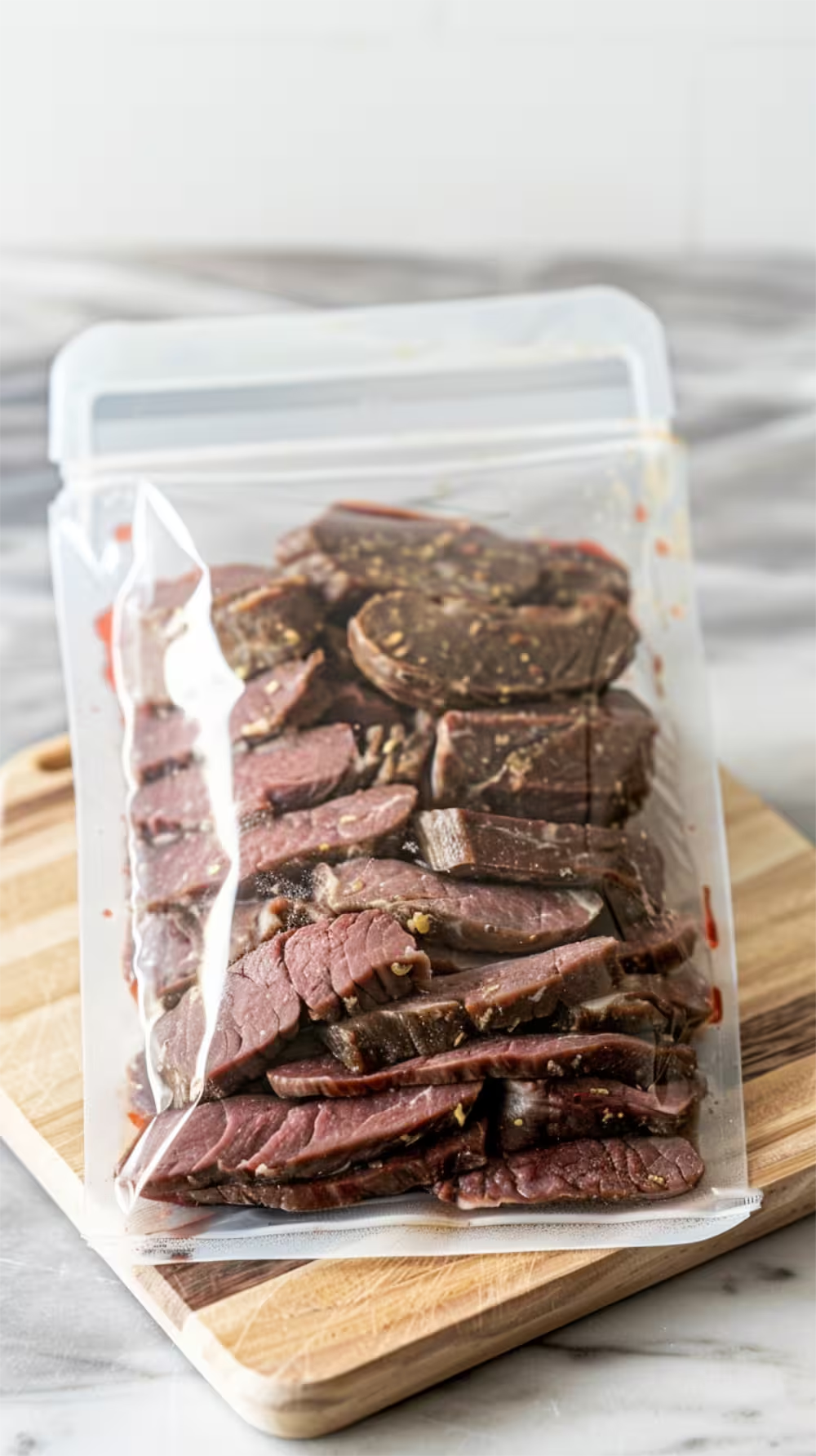
Storing Cooked Roast Beef the Right Way
Great news now you have your roast beef ready for the freezer. Now, let’s talk about keeping that savory goodness just as delicious in the freezer. Here’s how to store cooked roast beef the right way so you can enjoy it down the road.
Stash it in the coldest part of your freezer, and you’ve just extended your roast beef’s shelf life. Pack your freezer so air circulation isn’t blocked. It’s important to maintaining an even temperature throughout the freezer. A little organization ensures your items in the freezer as well as your roast beef will freeze uniformly.
How Long to Can you Keep Roast Beef in the Freezer
Your roast beef has now been wrapped properly, stored in the freezer in the best spot, now how long can it stay there and still be good?
The best results come when you stash it away for no more than 2-3 months, that’s the recommended storage time. That’s your sweet spot for keeping that savory flavor locked in. Going beyond that time? Well, it’s safe, but the taste might start to deteriorate. You’ve put effort into that roast. Let’s keep it tasty and make a plan to use it up within 3 months.
If you’ve put the date on the container you will know how long it’s been in the freezer. That way, you won’t have to play the guessing game later on.
Remember, take it out, thaw it properly, and it’s like you’ve turned back the clock to that fabulous dinner night. Trust me, your taste buds will thank you!
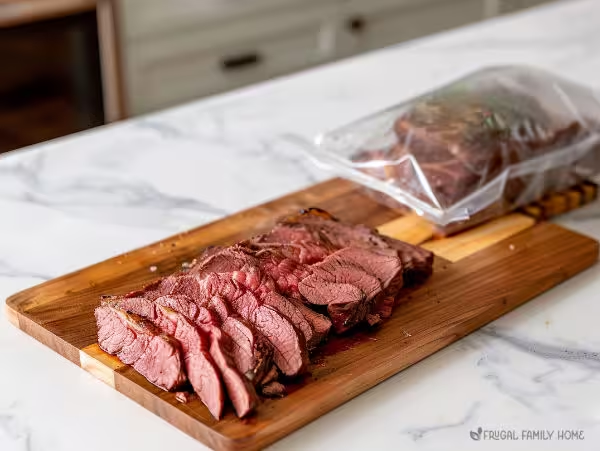
Safe Ways to Thaw Frozen Cooked Roast Beef
You did all you could to preserve the flavor and quality of your roast beef. Now you’re ready to enjoy it for another meal. This is how you thaw it in the safest way.
First off, take it out of the freezer and let it thaw slowly. Yes, slow and steady wins the thawing race. Place that bundle of future deliciousness in the fridge. Give it time. It might take a day, maybe more if you’ve got a large piece of meat. The good news is if you have small portions or thin slices they will be likely to thaw quicker.
But maybe you’re in a pinch? You need that roast beef, and you need it now. Here’s a tip: cold water is what you need, it might seem tempting to use warm water, but you need cold water. Keep the meat in its sealed package, dip it in a cold water bath, and keep that water chilly by changing it every 30 minutes.
Keep that process going, and that beef will be ready before you know it. Patience with this method brings your beef back to its prime without the risk of bacterial guests.
Microwaves might seem like a quick fix, but they can be tricky. They might not thaw your meat evenly. If you choose to go down this digital road, set it on the defrost mode, but stay vigilant. The moment it hits that just-thawed phase, get it out and ready to reheat.
You’ve worked hard for that mouthwatering flavor, and taking care of how you thaw preserves every bit of that savory goodness.
How to Reheating Your Cooked Roast Beef
Got your roast beef out of the freezer? Great! Now, let’s get it ready to serve. You want it just as tasty as the day it was first cooked. Here’s how you do it.
First, patience is your friend. Don’t rush the reheating process, or you might just end up with a tough, dry roast beef on your plate.
Start by preheating your oven to a gentle 250 degrees Fahrenheit. This low-and-slow method is what you want. Place the thawed meat in a baking dish and add a splash of broth or water. Cover it with foil to lock in the moisture. It’s like giving your beef a little steam bath to wake it up.
Place the prepared dish into the oven. You’re aiming for an internal temperature of 165 degrees Fahrenheit. This is the magic number for food safety, so use a meat thermometer to check it. Once it hits the target, your roast beef is ready to enjoy.
Remove your roast from the oven and let it rest for a few minutes. Those juices need a chance to settle back into the meat. Take the extra time to reheat your roast; you’ll be glad you took the extra care when you take that first savory bite.
Frequently Asked Questions
- Can I freeze cooked roast beef? Yes, you can. Wrap it tight to keep the quality intact.
- How do I prevent freezer burn on my roast beef? Use airtight containers or wrap in heavy-duty aluminum foil or plastic wrap, then place in a freezer-safe bag.
- What’s the best way to thaw frozen roast beef? Thaw it in the fridge for safety and to preserve flavor. Never at room temperature.
- Will the texture of roast beef change after freezing? If properly stored, the texture change is minimal. It remains savory and delicious.
- How long does cooked roast beef last in the freezer? For the best quality, use it within 2-3 months, but it’s safe beyond that.
- Is it safe to cook roast beef from frozen? Yes, adjust cooking times accordingly. A slow cooker or oven works best.
- What’s the internal temperature my roast beef should reach when reheating? Aim for at least 165°F to ensure food safety.
- Can I slice roast beef before freezing? Slicing before freezing is a good idea for quicker thawing and convenient serving sizes.
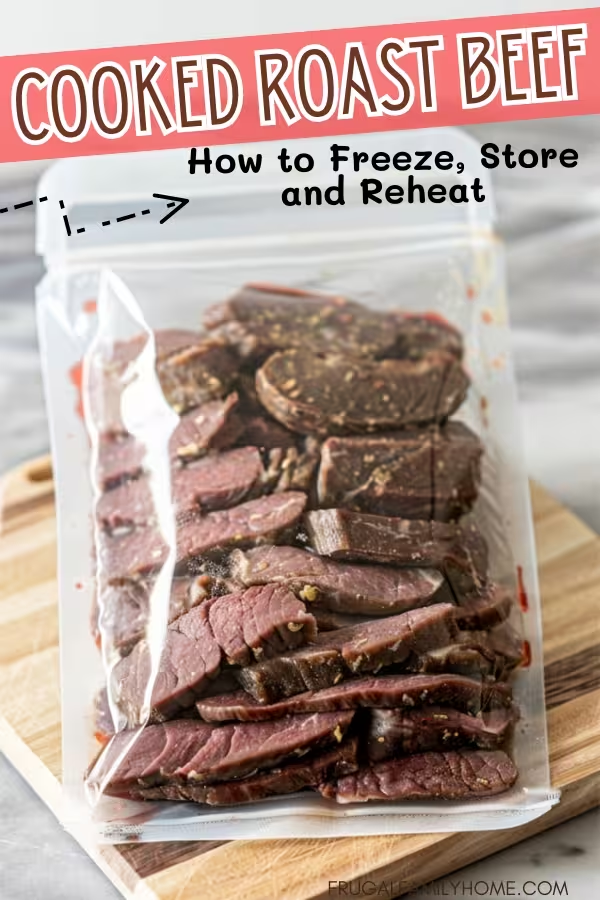
What to Make with Leftover Roast Beef
Got that leftover roast beef from last Sunday’s dinner sitting in the freezer? Don’t just think sandwiches. Get creative.
Thawed roast beef offers a slew of possibilities. How about slicing it thin, then tossing with peppers, onions, and a savory sauce for a quick and easy beef stir-fry?
Or, shred it and mix it into a bubbling pot of beef stroganoff for a comforting mid-week meal.
You could also chop the roast beef and use it in place of ground meats in a recipe like shepherd’s pie.
Another way to enjoy your cooked roast beef is to make it into a casserole. First make a batch of egg noodles. Then in a skillet cook broccoli florets, onions, and mushrooms. Once they are tender crisp add the diced roast beef. Heat until warmed through. Make a batch of brown gravy. Place the cooked egg noodles in a dish. Add the prepared brown gravy to the beef and vegetables, stir to combine. Then scoop onto the egg noodles.
And for those days when time isn’t on your side, consider laying pieces of roast beef on a fresh green salad for a balanced meal that’s ready in minutes.
No matter how you use your leftover roast beef, you’ll love having cooked beef in the freezer to use in so many ways and make getting dinner on the table easier.

